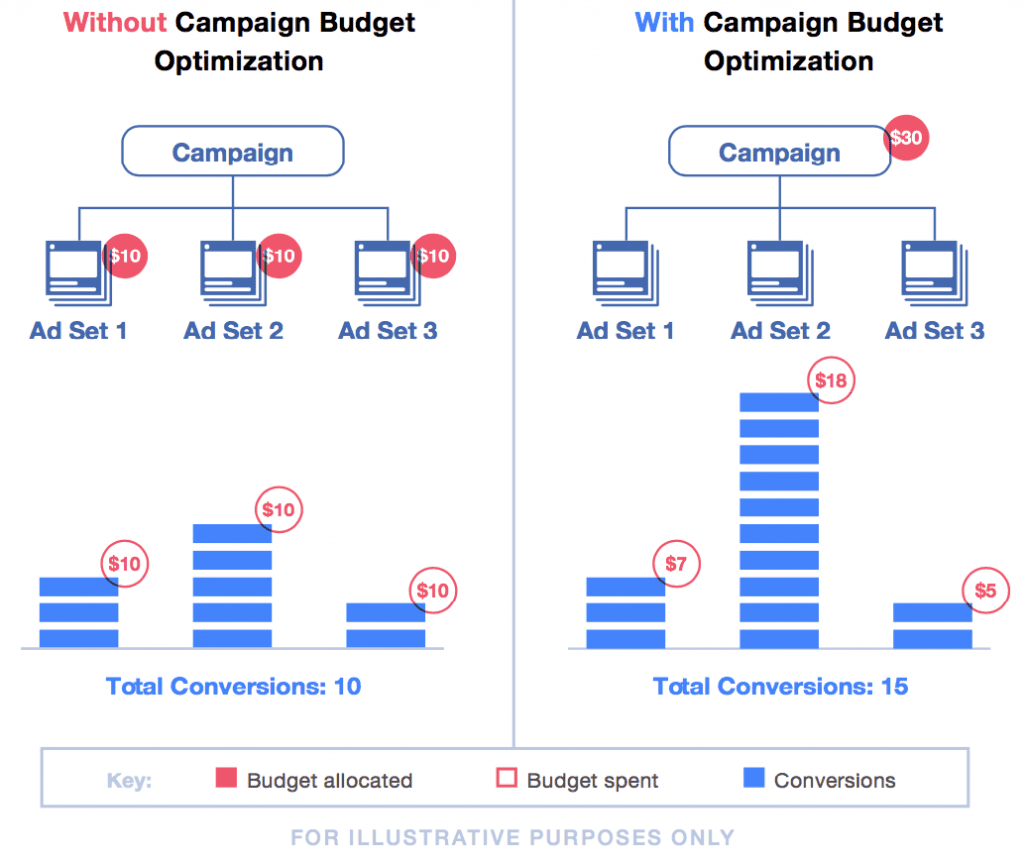A while back, I wrote that the future of PPC advertising was automation. Facebook’s Campaign Budget Optimisation (CBO) adds fuel to the fire.
Campaign Budget Optimisation is Facebook’s automated bid feature designed to automatically distribute budgets to best-performing ad sets and ads. Launched as a beta in 2017, CBO used to be an optional feature for advertisers but now it’s a fixed default setting.
So how does it benefit advertisers? And who will it affect the cost of Facebook marketing for advertisers?
How Campaign Budget Optimisation works
Before you can understand the benefit of CBO, you need to know how it works.
Your Facebook account follows this structure:
- Campaigns.
- Ad sets.
- Ads.
Without CBO, you could set budgets for each campaign manually. This means a lot of time looking at the data and knowing which audiences and adverts were performing best in order to push the most spend towards these.
That’s not a one-time action either. It’s something that you had to constantly analyse and alter – otherwise, your money might be thrown away on the wrong horse.
However, CBO does this for you across your whole campaign. You set your budget and it will automatically split it between the best performing ad sets and ads.

The benefits to Campaign Budget Optimisation
The first and most important benefit is time. Using CBO means you no longer have to spend time painstakingly altering your bids based on the latest data.
It does it for you, giving you a lot more time to do more important things. And that’s the whole point to any automation feature. They’re designed to do manual bits of hard work for you, freeing your time.
It’s why AI is becoming a necessity.
CBO does more than just free up time though. Our Paid Social Manager, Matt Hogan says:
“Since the launch of CBO, Facebook marketers are sleeping a little easier at night. It allows Facebook to take control of distributing the campaign budget across ad sets by weighting that budget more to better-performing ad sets and ads. This takes an element of control from the marketer, but ultimately, takes the stress away from optimising as well.”
Better return on ad spend (ROAS)
Another key benefit of CBO is that it can potentially deliver a better ROAS and more bang for your buck.
That’s because CBO will automatically direct your budget to the best performing ad set and ads for the goal you’re trying to reach. So, if you’re trying to boost website traffic, the ones with more clicks will get more money behind them. If you’re trying to boost conversions, the ones with the highest conversion rate will have a budget increase.
Find what works best and put more of your budget into your winners. After all, if you know which horse is going to win, why wouldn’t you put your money there?
How CBO performs for businesses
When BuzzFeed used CBO for their branded content ads, they generated an impressive:
- 100% increase video views
- 10% drop in cost per video view
- 5% drop in cost per click
To ensure that the results were purely down to CBO, BuzzFeed also carried out split testing of the campaign. The campaigns were identical apart from one campaign using CBO while the other didn’t.
The results? The campaigns using CBO outperformed the other ad group. Every single time.
Not giving the kids a chance
It’s not all sunshine and rainbows though. There are a few drawbacks to CBO. The biggest downside is that it makes testing new adverts difficult.
Let’s say you’re running a campaign to increase conversions for your brand new underwear line. You’re getting great results so far and want to add a lookalike audience to this campaign.
So you set up a new ad set and ads and click go, wondering how they’ll compare to the existing ones you have in place. But with CBO, your new ads won’t get a chance to perform. With no previous data behind them, the bulk of your budget will be going to the ads that are already performing.
The playing field is already geared towards another set of ads, making it impossible to see which are your best performers.
Campaign budget optimisation in a nutshell
There are pros and cons to any feature. When it comes to CBO, the benefits far outweigh the negatives.
It’s worth noting that there’s a difference between using something and getting the best use of it.
CBO and automation can do a lot for you, but you need to know how to use AI to get the best results for your company. It doesn’t magically make your campaigns better. There is some groundwork to do and best practices you should follow for maximum results.
- Make sure your account is structured in the right way – With CBO, you set your budgets at campaign level, which will automatically get broken down to the best-performing ad sets and ads. To get the best results, you need to ensure that your campaigns are ultra-focused and targeted.
- Give it time – CBO works on data and can’t make massive improvements straight away. At first, CBO will distribute your budget evenly between campaigns. But give it time to settle and work its magic.
- Continue making great ads – Don’t let this new system interfere with the results so far. Use your own data to better your results and test your way to success. Just be mindful of how CBO can change your testing process.
If you do all that, CBO will be just the feature you’ve been missing to save time and boost your ROAS.



